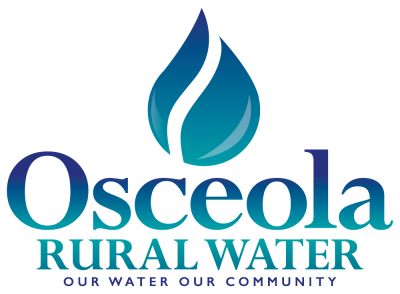Water Quality
September 29, 2021
Have you noticed a difference in your tap water?
As part of being a public water supply, there are many considerations to be made in an effort to provide safe, clean, and reliable drinking water. Emergency preparedness is one such consideration and such, Osceola Rural Water has procedures in place to deal with many different scenarios including the current issue in dealing with drought.
The past year and a half, Northwest Iowa has received well below average rainfall, and most would consider us to be in a severe drought. The Ocheyedan River Valley Alluvial Aquifer depends solely on rainfall to recharge its basin and not receiving adequate rainfall, the static water levels are down considerably. Preparing for the worst of times can be a difficult decision and one that is not taken lightly. In March of 2020, we participated in a drought workshop facilitated by the ISU Extension and the Drought Mitigation Center at the University of Nebraska to discuss the 2012 drought in Northwest Iowa and the future possibility of a multiyear drought and the effects it can have to those of us in NW Iowa with shallow alluvial aquifers.
This year, we had an abnormally early heat wave that, compounded with the lack of rainfall, prompted water consumption to increase substantially. With predictions of an impending drought (preceded with very little precipitation last fall), Osceola Rural Water began communications with the Iowa Geological and Water Survey Bureau to help monitor the unfolding events. Recognizing the effects of the drought on our shallow water supply, Osceola Rural Water, in an effort to practice water conservation, made a conscious decision to re-structure and take advantage of our back-up water supply (Dakota Cretaceous Aquifer – AKA “Deep Well” water). At no time has Osceola Rural Water been REQUIRED to take these actions, nor have they been recommended to do so by the Iowa Department of Natural Resources.
Conservation does not mean to prohibit the use of a natural resource for protection; but to utilize it in such a manner that is sustainable and protected for generations to come. We believe, that by electing to limit the amount of shallow well water withdrawn from the alluvial aquifer impacted by the drought and utilizing our deep well source to supplement these restrictions, we will protect the health and sustainability of the aquifer during these challenging times.
What does this change mean for you and your water at the tap?
Our deep wells have a higher level of hardness by comparison to our shallow wells. When blending deep well water with the alluvial water, the finished water has a hardness level of what is referred to as grains of hardness, measuring approximately 38 grains per gallon (650ppm). Our normal shallow well water grains of hardness are around 25 (442ppm). As you can see, this is not a large increase, but if you do not have a softener; you will most certainly be able to observe the difference in your home. If you do have a softener, you may need to adjust the settings to account for this increase in hardness. This will require the use of more salt over time but will still result in a product you are satisfied with.
When will we return to normal operations of only shallow well water?
We are committed to protecting the Ocheyedan Alluvial aquifer, and do not foresee any changes until the drought conditions have ceased. We are not short of water, nor are we asking you the customer, to conserve any more than you normally do. We realize the water chemistry we are providing you has changed, and we want to assure you that Osceola Rural Water continues to provide high quality, safe drinking water!
For more information about related topics in Northwest Iowa please visit the following link below.
Iowa Department of Natural Resources- Water Summary Update- Every Two Weeks
https://www.iowadnr.gov/Environmental-Protection/Water-Quality/Water-Summary-Update
For additional information on the information in this Water Summary Update please contact any of the following:
General Information - [email protected] 515-452-6633
Drought Monitor and Precipitation - [email protected] 515-281-8981 Stream Flow - Daniel Christiansen, [email protected] 319-358-3639
Stream Flow - [email protected] 515-725-0336
Shallow Groundwater - [email protected] 515-725-0336
US Drought Monitor- Midwest
https://droughtmonitor.unl.edu/CurrentMap/StateDroughtMonitor.aspx?Midwest

